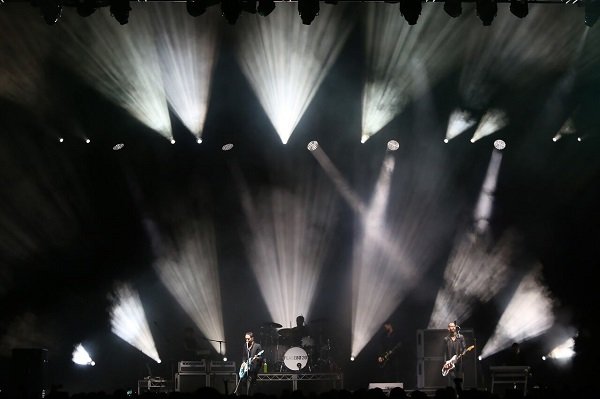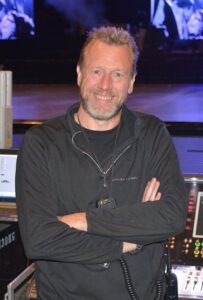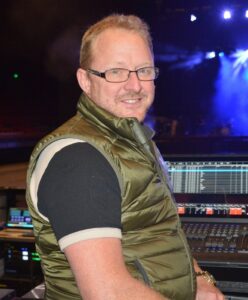News
24 Oct 2017
20 Years of Placebo Tour

Subscribe to CX E-News
ROADSKILLS
The enduring British band Placebo celebrated 20 years of brash rock and roll.
By Cat Strom.
 The 20 Years of Placebo tour celebrates the band being at the forefront of the alternative rock movement and while they still appeared wild and youthful, the same could not be said for the crew at Sydney’s Qudos arena! In fact, after an over-nighter that resulted in only two hours of sleep, thoughts of retirement were high on the agenda.
The 20 Years of Placebo tour celebrates the band being at the forefront of the alternative rock movement and while they still appeared wild and youthful, the same could not be said for the crew at Sydney’s Qudos arena! In fact, after an over-nighter that resulted in only two hours of sleep, thoughts of retirement were high on the agenda.
Ian Nelson has been mixing FOH for Placebo since 2001 and nowadays he tours with no one else, working at Adlib in Liverpool when the band are not on the road. However he has just turned fifty and has a two year old daughter so he’ll be hanging up his headphones after this tour.
JPJ Audio were supplying most of the tour, with Ian and Bruce Johnston being long time buddies, and in Qudos they supplied an L-Acoustics K1 system with a main hang of four K1-SBs, twelve K1 with six Kara under-hangs and side hangs of V-Dosc and dV-Dosc. Twenty-four SB28 subs were left and right stacked with a centre stack in front of the stage. Left and right there were ARC infills and a row of Karas across the front of the stage. Everything was LA8 amplified.
“So far today everyone is smiling!” said Ian. “I like L-Acoustics, we have a lot of K1 and K2 at Adlib. In Europe we toured a system from a German manufacturer called Coda which was very small, compact and powerful. It worked really well for us and the main box is only 38 kilos in weight. It has phenomenal performance and saved us a vast amount of truck space.”
FOH Ian ran a DiGiCo SD12 console, having started the world tour on an SD7 and switching to the SD12 for the European festival run as it is more compact.
Outboard effects included a Tube-Tech CL1B to compress Brian’s vocal, a couple of TC Electronics M4000 (one used for a snare reverb and one for Brian) and a Yamaha SPX2000 for distortion on Brian’s vocal in a couple of tunes.
“The Yamaha SPX is very usable for that sort of thing and I first used it when I did FOH for The Prodigy,” said Ian. “Keith always liked me to distort his vocal and it was purely by accident that we had one in the rack and it’s a very controllable distortion. You can imagine a vocal that is really loud in the PA and then sticking a distortion on it, it could easily go very wrong.”
A Placebo performance is a big rock show and that’s the vibe Ian goes for when mixing. He says that a lot of the sounds that the band produce can be quite hostile as they like a chaotic, loud sound.
“There are a lot of guitars – they tour sixty between the three guitar players – and so there are an awful lot of effect pedals going on so a lot of what I do is controlling some of the more hostile sounds they generate,” explained Ian. “I use a lot of dynamic EQ because otherwise trying to chase all the different guitars with their pedals is too much. I don’t use a lot of compression and no buss compression at all, the show has to be really dynamic. There are some properly loud bits and then some quiet bits as well. Personally I think a live show needs to have that dynamic, if it’s raging and loud all the time it can be a fatiguing experience for the audience.”
Microphones were mostly Shure and what you would pretty much expect, except for an Audix D4 on the snare as Ian likes the warmth on the low end.
“It really gives the snare a lot of impact,” he said. “I actually dial low frequency into the snare so you get a real thump off the snare drum. The other thing I do is under-mic the cymbals with Shure Beta 98 because for the IEMs, it’s really nice to get a good image across all the cymbals by having them under-mic’d.”
On the guitars Ian uses a combination of Shure Beta 181, Beta 27 and Radial JDX DI, taking those three sources to a subgroup and then mixing the show on the subgroups. Each guitar player has these three sources and then they’re all individually subbed together to their own groups.
“I do dynamic EQ and a little multiband compression on the subgroup and time align the DI’s back to the microphones,” Ian added. “Vocal wise it’s all Beta 58’s – nothing too fancy. I’m very much a meat and potatoes engineer, I like to keep stuff as simple as possible. Complication just brings headaches. That combination of microphones has worked for us for quite a long time.”
Everyone is on IEMs although there are two subs on stage for side fills plus the drummer has a thumper and the keyboard player has a sub behind him as he also plays bass guitar. Monitors were mixed by Finn Ragnarsson. The band purchased their own monitor gear including an Avid Profile and carry
a full transformer isolated line system that tours everywhere with them.
Placebo’s striking visual design was by Jvan Morandi who is well known for his original visual concepts and has worked for Placebo since their “MEDS” album in 2006. Each time they go on the road
he brings something fresh and interesting to the production visuals.
Jvan decided upon a fairly simple clean look for the stage. Described as like a lightbox but with moving image, the stage featured a large video presence which was unusual for this act. The show is very moody with a lot of back light and never any followspots. The band are often silhouetted, dark is as important as light.
Ex-pat Trent O’Connor was on the road with the band and not unexpectedly, the set up in Australia was completely different from the rest of the tour. The Robe Spiiders, BMFLs and Pointes, Kinyses system, Chauvet Rogue R1 and Claypaky Stormys were gone to be replaced by local vendor PRG with Claypaky B-EYE K20, Martin MAC Vipers, Claypaky Sharpys, MAC101s, GLP X4 impression and TMB Solaris Flares.
“It’s just a case of using whatever you get wherever you get,” said Trent. “We’ve just finished a European run of festivals and I think we had every possible mixture of light from around the world. Fortunately the Chamsys MQ500 console I’m using makes cloning very easy.”
Trent is fairly recent convert to the Chamsys and he has been impressed by its performance and the support offered by the company. However he further commented that all the high end consoles on the market do the same thing and what matters is what an operator does with it. Trent runs all the show visuals from the ChamSys MQ500 including the Catalyst media server with a camera input running into it.
Placebo Qudos Arena, Sydney (Photos Troy Constable © CX Media)
Fergus Noble is the touring video director for Jvan and his set up comprises one FOH long lens camera (Fuji 77x long lens, mounted on a HXC 100) operated by Justin Brown and four robotic camera’s (Panasonic AW HE70 4K) on stage which are operated by Bobbi Nolevski.
Fergus also has five static cameras (Marshal CV052M) and runs everything through a BMD ATEM production studio. Onstage, behind the semi-transparent 18m x 6m, 18 mm pitch LED screen (Roe MC-18 in Tait Towers touring frames) at the back, is ‘the matrix’ comprising of three trusses, each rigged with five Claypaky Sharpy, twelve Martin MAC101 fixtures and six 2-cell Moles. When these lights switch on they add a large amount of depth to the space and an additional dimension as they shoot through what initially appears to be a solid surface. The main screen is flanked either side by 4.2m x 5.4m deep, 7mm pitch Roe MC-7H screen in Acass-Systems touring frames that extend the visuals making the stage appear larger than reality. Each side screen is topped with
a truss holding three Solaris Flares and a couple of 4-cell Moles.
One rear truss and a front truss all contain B-Eyes, Vipers and Solaris flares with the addition of 4-cell Moles on the front truss. Trent uses the fan effect with the rotating lens of the K20 B Eye to duplicate the flower effect of the Robe Spiders.
On the floor upstage are eight Martin MAC Vipers, on the deck; 10 x TMB Solaris Flares which are also used for colour washing effects and back light plus eight 2-lite Moles. On the SL and SR sides of the stage on the floor are the GLP X4 impressions for low level cross lighting and effects as well as for beaming out into the audience pulling them into the stage action.
The show was heavy in smoke, even in Qudos Arena, with four Look Solutions Unique hazers and two JEM ZR33’s, all with fans, allowing for some beautiful beams.
Trent and Fergus would like to thank PRG’s Fergal O’Sullivan for all his help and sending out a fantastic crew; Casey Lorain (crew chief), Andy Mutton and Albert Nocum. They’d also like to mention Big Picture’s Nick Hemingway for all his help and his fantastic crew as well; Philip Pieridis (crew chief), Justin Brown and Bobbi Nolevski.
This article first appeared in the print edition of CX Magazine October 2017, pp.46-51.
CX Magazine is Australia and New Zealand’s only publication dedicated to entertainment technology news and issues. Read all editions for free or search our archive www.cxnetwork.com.au
All images © CX Media
Subscribe
Published monthly since 1991, our famous AV industry magazine is free for download or pay for print. Subscribers also receive CX News, our free weekly email with the latest industry news and jobs.













